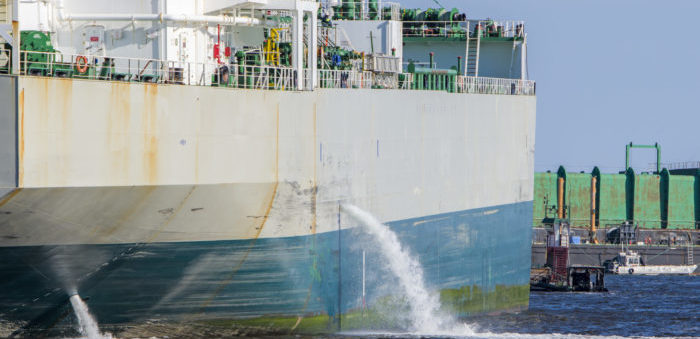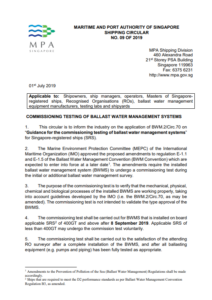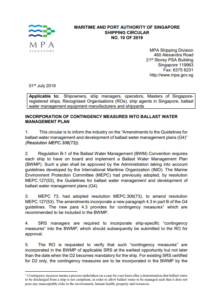Singapore flagged vessels should bear in mind recent MPA Singapore circulars, regarding the commissioning testing of ballast water management systems (BWMS) and the incorporation of contingency measures into ballast water management plans (BWMP).
Commissioning testing to ensure the right operation of equipment must be conducted at the installation of any BWMS, according to the Guidelines for Approval of Ballast Water Management Systems.
[smlsubform prepend=”GET THE SAFETY4SEA IN YOUR INBOX!” showname=false emailtxt=”” emailholder=”Enter your email address” showsubmit=true submittxt=”Submit” jsthanks=false thankyou=”Thank you for subscribing to our mailing list”]
In fact, MEPC 74 has approved a draft amendment to the Ballast Water Management Convention (BWMC), to perform commissioning testing, in order to showcase through sampling and analysis that a BWMS is working efficiently. This amendment is expected to be adopted at MEPC 75.
Before this amendment applies, Singapore flagged ships of 400GT and over that complete the commissioning testing of a BWMS after 8 September 2019, will must collect and analyse samples of ballast water during the commissioning testing. However, ships less than 400GT do not have to comply with this requirement.
In case that a test is unable to be carried out, because of problems in the equipment or system design, then a short term BWM certificate may be issued for a period of not over three months by the classification society, if the attending class surveyor is able to verify the items described below:
- Reasons for the commissioning test not being completed successfully are recorded in the ballast water record book;
- The attending RO surveyor is provided with arrangements for the commission test (e.g. date, time, location);
- The ship’s ballast water management plan (BWMP) has incorporated appropriate contingency measures in line with the “Amendments to the Guidelines for ballast water management and development of ballast water management plans (G4)” (Resolution MEPC.306(73));
- The ship’s Master and the designated ballast water management officer are aware of the “Guidance on contingency measures under the BWM Convention”, BWM.2/Circ.62, as may be amended, in particular on the communication between the ship and the port State;
- The ship’s Master and the designated ballast water management officer are aware of the reporting requirements to the competent port Authority as per regulation E1.7 of the BWM Convention when the vessel is calling a foreign port and shall comply with any additional requirements that the port State may impose.
What is more, MEPC 71 has approved the Guidance on Contingency Measures under the BWMC, aiming to help vessels and Port States apply sound and practical measures in situations where a ship cannot manage its ballast water as required. Amendments regarding this were adopted by MEPC 73, in order to contain contingency measures in the BWMP.
In addition, Singapore flagged ships to which the BWMC applies must include contingency measures into their BWMPs. These measures must receive approval by a classification society and they must be provided on board no later than the date when D-2 compliance becomes mandatory for the ship.
For existing Singapore flagged ships certified for D-2 only, contingency measures are to be included into their BWMPs by the next scheduled survey for the BWMC.
Moreover, the inclusion of contingency measures into the BWMP also applies for Singapore flagged vessels of no more than 400 GT, floating platforms, floating storage units (FSUs) and Floating Production Storage and Offloading Units (FPSOs) by 8 September 2024 or upon the installation of a BWMS on board.
Finally, a ship-specific contingency measure could be approved as an appendix or an addendum to the BWMP. Nevertheless, Standard Club explains that this does not mean that Singapore flagged ships are allowed to discharge unmanaged ballast water without Port Authority authorisation.






























































